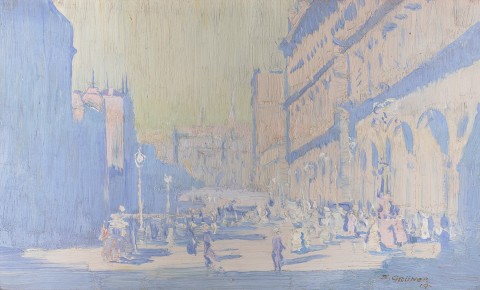THE BUSTLE OF LIFE (also known as MARTIN PLACE, SYDNEY), 1914
ELIOTH GRUNER
oil on wood panel
13.5 x 23.0 cm
signed and dated lower right: E. GRUNER / 14
bears inscription verso [partially obscured]: … Hobart / 1914.
Mildred Lovett (Mrs Stanley Paterson), Hobart, acquired directly from the artist, 1914
Gordon Esling, Sydney
James R. Jackson, Sydney, 1951
Sotheby’s, Melbourne, 7 May 2001, lot 121 (as ‘Paris’)
Savill Galleries, Sydney
Private collection, Sydney, acquired from the above
Society of Artists’ Annual Exhibition, Society’s Rooms, Queen Victoria Markets, Sydney, November 1914, cat.165 (as ‘The Bustle of Life’, lent by Mildred Lovett)
Elioth Gruner Memorial Loan Exhibition, National Art Gallery of New South Wales, Sydney, 17 April – 31 May 1940, cat. 213 (as ‘Martin Place’, label attached verso, lent by Mrs S. Paterson)
We are grateful to Steven Miller, Head of the Edmund and Joanna Capon Research Library and Archive, Art Gallery of New South Wales, for his assistance with this catalogue entry.
Elioth Gruner’s Bustle of Life 1914, is a painting filled with light and activity, intensified by its modest scale. Gruner stood next to the General Post Office (GPO) building and painted the view looking up the incline, creating what is known as an enfilade view in the process. Originally called Moore Street, though also known colloquially as ‘Post Office Street’ until the early 1920s, Martin Place no doubt follows an original track laid down by the Cadigal people as they took a short cut overland through what are now the Botanic Gardens, trekking between the two fishing grounds of the contemporary Circular Quay and Woolloomooloo Bay. The location was only 200 metres from the small gallery that Gruner managed in Bligh Street, and judging by the sunlight and midday shadows, probably began life as a paint sketch on one of his lunchbreaks, later finished in his studio.
Encouraged by his mother, Gruner displayed an early talent for art and, by the age of 12, was attending drawing lessons with Julian Ashton, enrolling formally at his art school two years later. In 1912, he worked at the Fine Arts Society’s gallery and part-time as school assistant to Ashton, but with the advent of World War One, the gallery closed and Gruner relied on teaching and painting sales to survive. He lived precariously, as recounted by John Brackenreg many years later, when Gruner told him that in 1913 ‘I had tuppence left in my pocket, so I walked in to Bondi Junction to catch a tram into city, wondering whether I had any luck to sell a picture (at The Society of Artists’ annual exhibition). (W)hen I got there they had sold the lot.’1 This was a 120-guinea windfall for the struggling artist. Starting with the arched colonnade of the GPO (opened 1874) at lower right, Gruner looks east up Moore Street from the George Street corner. Midway is the Pitt Street crossing where thoroughfare became a narrower laneway leading to Castlereagh Street and beyond. The tall building beyond the GPO housed the Reuters news agency, and in the distance may be seen the spire of St Stephen’s church. On the left stand a variety of office buildings containing shipping agents, government departments, accountants, dentists and other professional workers. Fashionable people, street barrows, and horses with carts populate the rest of Gruner’s scene.
This vista was radically changed by the early 1930s when the Place was widened and lengthened with a number of buildings, including St Stephen’s, demolished in the process. Controversially, the church was then rebuilt in Macquarie Street resulting in the lamented demolition of Burdekin House, long considered the most beautiful colonial house in Sydney. As such, Gruner’s Bustle of Life presents a lost moment in time – one of the last days of summer pleasure before the catastrophe of the war erupted in August. Within weeks, this scene had transformed into a major centre for volunteer soldier registration and was later filled with passionate crowds debating the divisive issue of conscription. In 1918, crowds again descended on Martin Place to celebrate the long-awaited Armistice.
1. John Brackenreg, 1982, cited in Pearce, B., Elioth Gruner 1882 – 1913, Art Gallery New South Wales, Sydney, 1983, p.14
ANDREW GAYNOR
